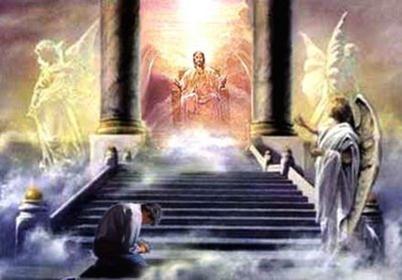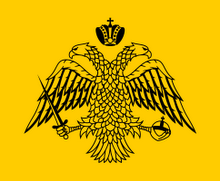Archbishop Eccleston offered up a Solemn Holy Mass, and Bishop Purcell of Cincinnati preached an appropriate sermon.
The ecclesiastical province of Baltimore at this time comprised the whole United States, and hence the Sixth Provincial Council was able to issue decrees for the entire country.
On May 13 the bishops of the United States who were gathered in the residence of the Archbishop and under his chairmanship for the third private meeting of the Council, which began at nine in the morning, adopted a decree by which they chose the Blessed Virgin Mary, conceived without sin, as Patroness of the United States.
This decree, translated from the Latin into English, is as follows:
With enthusiastic acclaim and with unanimous approval and consent, the Fathers [of the Council] have chosen the Blessed Virgin Mary, conceived without sin, as the Patroness of the United States of America; without, however, adding the obligation of hearing Mass and abstaining from servile work on the feast of the Conception of Blessed Mary. And, therefore, they decided that the Supreme Pontiff be humbly asked to transfer the solemnity, unless the feast fall on a Sunday, to the nearest Sunday, on which both private and solemn Masses may be celebrated of the feast thus transferred, and the vesper office of the same feast may be recited.Shea tells us that it was "to gratify a pious desire pervading the whole United States," that "the Fathers of the Council petitioned the Sovereign Pontiff to ratify their choice of the Blessed Virgin Mary, conceived without sin, as Patroness of the United States, and to transfer the solemnization of the feast to the following Sunday."1
In the fourth private meeting of the Council, held on May 15, same time and same place, the bishops of the United States agreed to ask the Holy See for permission, in all the dioceses of the country, to add the word "Immaculate" in the orations and preface of the divine office and Mass of the Conception of Mary; and also to add in the Litany of the Blessed Virgin the invocation: "Queen, conceived without sin, pray for us."
The latter favors were granted first, by Pope Pius IX, in an audience on Sept. 13, 1846, and announced by the Sacred Congregation of Propaganda (to which the Church in the United States was subject at that time) in a decree published two days later. When the Sixth Provincial Council of Baltimore met the ruling Pontiff was Gregory XVI. He died on June 1 of that year, and was succeeded by Pius IX on June 16.
The choice of Our Lady in her Immaculate Conception as Patroness of the United States was approved by Pope Pius IX in an audience on Feb. 7, 1847; and this approval was announced in a decree of Propaganda dated July 2, the same year. Both of these decrees of Propaganda have the signature of Cardinal Fransoni.
Two more decrees, issued by the Congregation of Sacred Rites on April 10, 1848, answered questions which had arisen. (1) The Mass of the Immaculate Conception, transferred to Sunday, has the Gloria and Credo and the Gospel of the Sunday at the end; and, if the Mass is sung, it has a commemoration only of the Sunday; if it is a private Mass, it has commemorations also of other feasts observed on that day. (2) The obligation of reciting the vespers of the divine office is satisfied by attendance at the vespers of the Immaculate Conception on the Sunday to which the feast is transferred.
It will be of interest to list the bishops who signed the decree by which the Immaculate Conception was chosen Patroness of the United States. The first was, of course, that of Archbishop Samuel Eccleston of Baltimore, the chairman of the Council. Then followed the signatures of twenty-two bishops, three of whom were coadjutor bishops (Louisville, New York, and Boston), one an administrator (Detroit), and one a vicar apostolic (Texas). The twenty-two bishops signed their names in the following order:
(1) Michael Portier, Bishop of MobileThe request of the American bishops for permission to add the word "Immaculate" in the orations and preface for the feast of the Conception of the Blessed Virgin requires some explanation. The feast of the Conception of Mary was celebrated in some places already in the thirteenth century; however, it did not clearly teach the Immaculate Conception. That was done in the Office "Sicut Lilium" and the Mass "Egredimini" of Leonard of Nogarolis, which was approved in 1477 by Sixtus IV; in fact, these had the same oration we have today for the feast of the Immaculate Conception. When Pius V revised the Roman Breviary in 1568, though the Franciscans were allowed to retain the Office and Mass of Nogarolis, this office was dropped for the rest of the Church and the office of the Nativity of the Blessed Virgin was substituted, the word "Conception" being substituted for "Nativity."
(2) Francis Patrick Kenrick, Bishop of Philadelphia
(3) John Baptist Purcell, Bishop of Cincinnati
(4) Guido Ignatius Chabrat, Coadjutor of Louisville
(5) Anthony Blanc, Bishop of New Orleans
(6) Matthias Loras, Bishop of Dubuque
(7) John Hughes, Bishop of New York
(8) Richard Pius Miles, Bishop of Nashville
(9) Celestine Rene Lawrence Guynemer de la Hailandiere, Bishop of Vincennes
(10) John Joseph Chanche, Bishop of Natchez
(11) Richard Vincent Whelan, Bishop of Richmond
(12) Peter Paul Lefevere, Administrator of Detroit
(13) Peter Richard Kenrick, Bishop of Saint Louis
(14) John Mary Odin, Vicar Apostolic of Texas
(15) Michael O'Connor, Bishop of Pittsburgh
(16) Andrew Byrne, Bishop of Little Rock
(17) William Quarter, Bishop of Chicago
(18) John McCloskey, Coadjutor of New York
(19) William Tyler, Bishop of Hartford
(20) Ignatius Aloysius Reynolds, Bishop of Charleston
(21) John Henni, Bishop of Milwaukee
(22) John Bernard Fitzpatrick, Coadjutor of Boston
When the American bishops asked for permission to add the word "Immaculate," they anticipated and perhaps influenced a step taken by Pope Pius IX a year after he had granted the petition of the American bishops. On Sept. 30, 1847, this Pope authorized for the diocese of Rome a new office and Mass proper to the feast of the Immaculate Conception and clearly teaching the doctrine of Mary's Immaculate Conception; and, two years later, he extended the new office and Mass to the universal Church.
On Dec. 8, 1854, eight years and four months after the American bishops had chosen Mary Immaculate as the Patroness of the United States, Pope Pius IX solemnly declared the Immaculate Conception of the Blessed Virgin Mary to be an article of faith. Numerous petitions for the definition of this doctrine had poured in during the preceding years; and Pope Pius IX had written the encyclical Ubi primum in which he asked the bishops of the world (1) how great the devotion of the faithful was toward the Immaculate Conception and how great their desire for the definition of this doctrine; and (2) what was the opinion and desire of the bishops themselves.
The American bishops, assembled in the Seventh Provincial Council of Baltimore, May 5-13, 1849, had given a favorable reply to both questions (in decrees I and II, on May 12), informing the Holy Father that the faithful in the United States were animated with a great devotion to the Immaculate Conception, and that they the bishops, would be pleased if the Holy Father declared the doctrine of the Immaculate Conception an article of faith.
The documents in which are recorded all of the facts mentioned concerning the Sixth and Seventh Councils of Baltimore are contained in volume three of the so-called Collectio Lacensis, containing the acts and decrees of the Councils of the bishops of North America and Great Britain from 1789 to 1869, and published by Herder at Freiburg in Breisgau in 1875.
It is interesting to note that among these documents there is one which tells us that Bishop Carroll had chosen the Blessed Virgin as patroness of the diocese of Baltimore at the time he was made bishop. The document in question is the minutes of the fifth session, on November 10, of the Diocesan Synod of Baltimore held in 1791, which was really the first national synod of the United States.
Long before the American bishops, in 1846, chose the Immaculate Conception as Patroness of the United States, a large portion of our country, namely that which has been called "Our Spanish Borderlands," had been placed under the patronage of Mary Immaculate.
It was in 1760 that Pope Clement XIII approved of the choice of the Immaculate Conception of the Blessed Virgin Mary as the principal and universal Patroness of Spain and its possessions; and that included Our Spanish Borderlands-the states of Florida, Georgia, Texas, New Mexico, Arizona, and California.
Long before that, however, the Spaniards, both in their homeland and in their world-wide colonies, excelled all other nations and countries in their love and veneration of Nuestra Senora de la Purisima Concepcion. The flagship of Christopher Columbus on his epoch-making voyage across the Atlantic in 1492 was named not merely Santa Maria, but according to some historians Santa Maria de Concepcion. To the second island he found in the New World, Columbus gave the name of La Concepcion after he had named the first San Salvador. From that time on, countless rivers, lakes, towns, missions in Hispanic America were named for and placed under the tutelage of La Purisima Concepcion.
In our own Spanish Borderlands no less than ten missions were dedicated to the Immaculate Conception, four in Florida, two in Texas, two in New Mexico, and two in California. The two in New Mexico, at Hawikuh and Quarai, were the first; and one of those in Texas, Mission La Purisima Concepcion near San Antonio, still stands today as it did when completed in 1762-the oldest church of the Immaculate Conception in the United States. The church adjoining the Franciscan friary at St. Augustine, Florida, founded in 1584 and dedicated to Mary Immaculate, was the first church of the Immaculate Conception in territory now a part of the United States.
As early as 1644 Pope Innocent X permitted the feast of the Conception of the Blessed Virgin to be made a holy day of obligation in Spain and its possessions, while it was only in 1708, under Clement XI, that the feast of the Conception of Mary became such for the whole Church.
In 1761, the year after the choice of the Immaculate Conception as Patroness of Spain had been approved by Clement XIII, Spain and its possessions also received permission to make use of the office and Mass of the Immaculate Conception, which was then in use among the Franciscans and which clearly taught and praised Mary's singular privilege of the Immaculate Conception.
A further concession was made to Spain and its possessions in 1767, when this office and Mass of the Immaculate Conception were permitted, not merely on December 8, but on every Saturday of the year except during Advent and Lent.
A symbol as well as instance of Spain's devotion to Mary Immaculate are the beautiful paintings of the Immaculate Conception by the great Spanish artist, Bartolome Esteban Murillo (1617-82). El Maestro, as Murillo is called, painted numerous pictures of the Immaculate Conception, the most famous of which is in the Louvre. It represents the Blessed Virgin surrounded by cherubs and standing upon the crescent, her hands folded on her breast and her eyes turned upwards. Similar to it is his famous painting of the Assumption, also in the Louvre.
The spirit of Murillo is indicated by the fact that he never began a religious painting without prayer and penance, and also by the practice of the pupils of the art school which he founded, who met with the salutation: "Praised be the Most Holy Sacrament and the pure Conception of Our Lady!"
The latter became, in fact, a favorite greeting and aspiration among Spaniards everywhere, particularly in the following form: "Alabado sea el Santisimo Sacramento del Altar! Bendita sea la Limpia y Purisima Concepcion de Nuestra Senora Maria Santisima sin mancha de pecado original!-Praised be the Most Holy Sacrament of the Altar! Blessed be the stainless and most pure Conception of Our Lady Mary Most Holy without the taint of original sin!"
In all the missions of Our Spanish Borderlands the Indians were taught to sing the beautiful Alabado at services in the church, similarly as we sing the Psalm Laudate after Benediction, and also at other times. The first verse of the Alabado praised the Blessed Sacrament; the second, the Immaculate Conception; and the third, St. Joseph. The first two verses are as follows:
Alabado y ensalzadoThe following is a literal translation:
Sea el Divino Sacramento,
En quien Dios oculto asiste,
De las Almas el sustento.
Y la limpia Concepcion
De la Reina de los Cielos,
Que quedando Virgen Pura,
Es Madre del Verbo Eterno.
"Praised and exalted be the Sacrament Divine in which God is present in a hidden manner and offers Himself as the food of souls! Praised also be the Immaculate Conception of the Queen of Heaven, who while remaining a pure virgin, became the Mother of the Eternal Word!"
Fr. Owen da Silva's book, Mission Music of California, has the following version in verse:
Lift your heart in joy and exalt HimThere is another form of the Alabado which combines these two verses into one:
In the Blessed Sacrament all Holy,
Where the Lord, His glory veiling,
Comforts souls true and lowly.
Laud the glorious Conception
Of the Queen in God's Kingdom supernal,
Who remaining Virgin stainless,
Bore for men the Word eternal.
Alabado sea el SantisimoAnd this followed by:
Sacramento del altar,
Y la Virgen concebida
Sin pecado original.
Ave, Ave,In 1846, therefore, when the bishops of the United States dedicated our land in a special manner to the Immaculate Conception, choosing the Blessed Virgin under this title as the special Patroness of our country, it was a re-dedication as far as that part was concerned which had once belonged to Spain-Our Spanish Borderlands, which were placed under the patronage of Mary Immaculate already in 1760.
Ave Maria!
Ave, Ave,
Ave Maria!
In his History of Devotion to the Blessed Virgin Mary in North America, MacLeod tells us that in 1862, of more than eight hundred churches in North America which were dedicated to the Blessed Virgin, 145 were named for the Immaculate Conception. Another count made by Fr. Maynard Geiger, O.F.M., in 1943, shows that out of 4,817 churches and institutions in the United States dedicated to the Blessed Virgin Mary, 637 honor the Immaculate Conception.
The United States of America is indeed the land of Mary Immaculate. Very fittingly the beloved poet-priest of the South, Fr. Abram J. Ryan, wrote one of his most beautiful poems in Baltimore on the night of Dec. 8, 1880, opening with these verses:
Fell the snow on the festival's vigil
And surpliced the city in white;
I wonder who wove the pure flakelets?
Ask the Virgin, or God, or the night.
It fitted the Feast: 'twas a symbol,
And earth wore the surplice at morn,
As pure as the vale's stainless lily
For Mary, the sinlessly born;
For Mary, conceived in all sinlessness;
And the sun, thro' the clouds of the East,
With the brightest and fairest of flashes,
Fringed the surplice of white for the Feast.
And round the horizon hung cloudless,
Pure stoles to be worn by the Feast;
While the earth and the heavens were waiting
For the beautiful Mass of the priest.
ENDNOTES
1 John Gilmary Shea, History of the Catholic Church in the United States (New York, 1886-92), IV, 28-30.
Franciscan Friary
St. Louis, Missouri
Taken from the June 1954 issue of "The American Ecclesiastical Review."
Electronic Copyright © 1996 EWTN
All Rights Reserved
All Rights Reserved
.
Provided Courtesy of:
Eternal Word Television Network
5817 Old Leeds Road
Irondale, AL 35210
www.ewtn.com
Eternal Word Television Network
5817 Old Leeds Road
Irondale, AL 35210
www.ewtn.com
The discovery of the aboe infromation came iniially in 2012, when opening a book, in my lap fell a booklet of Novena payers to mary of the Imaculate Conceptioin...My realisation with this for as long as this land isgiven to be the Patroness of America, then Christ automatically would be watching over he land and people too... reading IN GOD WE TRUST on the Dollar made sense with this....
Bishop Carroll is identified and the Carroll Foundation Trust connected with Maryland...so I was meant to see this too...the information above provides more detail and so tthere are people who have preserved the truth even to this day...and there are those who will not be silent about the deception to people...
Looking at the previous article about Cape Fear...Sam is an abbreviation of SAMUEL..The name Samuel in England is connected with the law firm who submitted dishonest affidavit to the High Court. I do not think it was a deliberate intention...They did not write it. UK Lawyers ignore Royal Law in context too..
SAMUEL was a prophet who anointed the King Saul.
In the Qur'anic account, Samuel prophesies to the children of Israel, telling them that the sign of Saul's kingship will be that the Ark of the Covenant will come back to the Israelites:
Their prophet said to them: "The sign of his kingship will be that you will come to have a chest (tabu't) full of peace and tranquility (Sakina) from your Lord and remainder of the legacy of the children of Moses and the children of Aaron, carried over by the angels. In this certainly shall be a sign for you if you really believe."
—Qur'an, sura 2 (Al-Baqara), ayah 247–248
Peace be with you
Pauline Maria








No comments:
Post a Comment